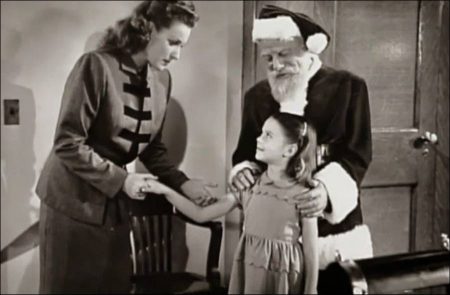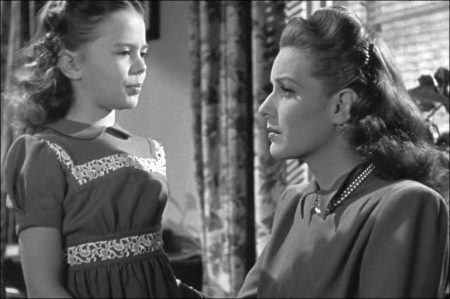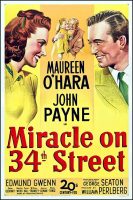Miracle on 34th Street movie storyline. At the Macy’s Thanksgiving Day Parade, the actor playing Santa is discovered to be drunk by a whiskered old man. Doris Walker, the no nonsense special events director, persuades him to take his place. He proves to be a sensation and is quickly recruited to be the store Santa at the main store. While he is successful, Doris learns that he calls himself Kris Kringle and he claims to be the actual Santa Claus.
Despite reassurances by his doctor that he is harmless, Doris still has misgivings, especially when she has cynically trained herself, and especially her daughter, Susan, to reject all notions of belief and fantasy. And yet, people, especially Susan, begin to notice there is something special about Kris and his determination to advance the true spirit of Christmas among the rampant commercialism around him and succeeding in improbable ways.
When a raucous conflict with the store’s cruelly incompetent therapist, Granville Sawyer, erupts, he finds himself held at Bellevue where, in despair, he deliberately fails a mental examination to ensure his commitment. All seems lost until Doris’ friend, Fred Gailey, reassures him of his worth and agrees to represent him in the fight to secure his release. To achieve that, Fred arranges a formal hearing in which he argues that Kris is sane because he is in fact Santa Claus. What ensues is a bizarre hearing in which people’s beliefs are reexamined and put to the test, but even so, it’s going to take a miracle for Kris to win.
Miracle on 34th Street is a 1947 American Christmas comedy-drama film released by 20th Century Fox, written and directed by George Seaton and based on a story by Valentine Davies. It stars Maureen O’Hara, John Payne, Natalie Wood, and Edmund Gwenn. The story takes place between Thanksgiving Day and Christmas Day in New York City, and focuses on the effect of a department store Santa Claus who claims to be the real Santa. The film has become a perennial Christmas favorite.
Miracle on 34th Street won three Academy Awards: Gwenn for Best Actor in a Supporting Role, Valentine Davies for Best Writing, Original Story, and George Seaton for Best Writing, Screenplay. The film was nominated for Best Picture, losing to Gentleman’s Agreement. In 2005, the film was selected for preservation in the National Film Registry by the Library of Congress as being “culturally, historically or aesthetically significant”. The Academy Film Archive preserved Miracle on 34th Street in 2009. Davies also wrote a short novelization of the tale, which was published by Harcourt Brace simultaneously with the film’s release.
About the Production
Miracle on 34th Street was shot on location in New York City, with the Macy’s Thanksgiving Parade sequences filmed live while the 1946 parade was happening. “It was a mad scramble to get all the shots we needed, and we got to do each scene only once,” Maureen O’Hara recalled in her memoir. “It was bitterly cold that day, and Edmund and I envied Natalie (Wood) and John Payne, who were watching the parade from a window.”
Although the film is set during the Christmas season, studio head Darryl F. Zanuck insisted that it be released in May, arguing that more people go to the movies in warmer weather.[7] The studio rushed to promote it while keeping its Christmas setting a secret. Fox’s promotional trailer depicted a fictional producer roaming the studio backlot and encountering such stars as Rex Harrison, Anne Baxter, Peggy Ann Garner, and Dick Haymes extolling the virtues of the film.
In addition, the movie posters prominently featured O’Hara and Payne, with Gwenn’s character kept in the background. The film opened in New York City at the Roxy Theatre on June 4, 1947. By contrast, modern home video packaging has Gwenn and Wood dominating the imagery, with the DVD release having Kringle in his Santa Claus costume.
O’Hara was initially reluctant to take the role, having recently moved back to Ireland. She immediately changed her mind after reading the script and came back to the United States for the film. Arthur Jacobson, assistant director, filmed the Macy’s Parade on Thanksgiving morning with nine cameras simultaneously. He said he “plunked actors Edmund Gwenn and Natalie Wood in the department store cafeteria line during a weekday lunch-rush”. When Maureen O’Hara requested a special police escort for a Christmas shopping spree through Macy’s he said “I know New Yorkers. They aren’t going to pay any attention to you. And don’t wear a bandanna around your head or dark glasses. Just be normal.”
The Christmas window displays seen in the film were originally made by Steiff for Macy’s. Macy’s later sold the window displays to FAO Schwarz in New York. FAO Schwarz then sold the windows to the Marshall & Ilsley Bank of Milwaukee, Wisconsin, where they are on display every December in the bank’s lobby on North Water Street.
The house shown at the end of the film is a 1703 square foot single family home built in 1943 at 24 Derby Road, Port Washington, New York. The home looks practically the same as it did in 1947, except that the roof line has been altered by the addition of a window. Rowland Hussey Macy, called R. H. Macy in the film, died 70 years prior to the film (in 1877), and the Macy family had sold its ownership of the company in 1895.
Miracle on 34th Street (1947)
Directed by: George Seaton
Starring: Maureen O’Hara, John Payne, Edmund Gwenn, Gene Lockhart, Natalie Wood, Porter Hall, William Frawley, Jerome Cowan, Philip Tonge, Jack Albertson, Harry Antrim, Arline Bletcher
Screenplay by: George Seaton
Cinematography by: Lloyd Ahern, Charles G. Clarke
Film Editing by: Robert L. Simpson
Costume Design by: Kay Nelson
Set Decoration by: Ernest Lansing, Thomas Little
Art Direction by: Richard Day, Richard Irvine
Music by: Cyril Mockridge
MPAA Rating: None.
Distributed by: 20th Century Fox
Release Date: May 2, 1947
Visits: 117


